Tomato fruit problems are very common for gardeners. It may happen for environmental effects, bugs, pathogenic attacks, or lack of care by the gardener.
Some fruit problems have some remedies, and some problems can destroy the whole effort. However, you can’t control the environment, but take some precautions to reduce the risk of the problems.
Here I discuss the most common tomato fruit problems and diseases and their possible solutions.
01: Blossom End Rot
Blossom end rot is a common tomato fruit problem caused by environmental effects and lack of nutrients. The problem appears when the growing season starts. Fruits become affected when they reach almost half of their actual size.
This is not a fungal or viral disease and doesn’t spread out from one plant to another. It is also common in pepper, squash, eggplant, cucumber, and melon.
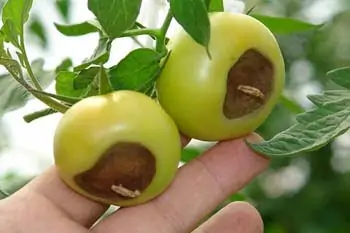
Causes and symptoms:
A water-soaked spot appears on the bottom of the fruit and enlarges, eventually turning dark brown and leathery.
Imbalanced soil nutrients like too much nitrogen or too little calcium during fruit development can cause the problem. Besides, a high salt level in soil or plant damage through plant care can also cause the problem.
Fluctuating soil moisture, poor drainage system, heavy rainfall, inadequate water supply, and drought can hamper calcium uptake to the plants, which causes blossom end rot.
Treatments and controls:
Disease-resistant tomato variety code: “BER”
- Provide adequate water supply to keep moisten the soil. A proper drainage system with aeration helps to set and grow healthy fruits.
- Mulching helps to hold soil moisture during the dry season.
- Sometimes foliar plants sprayed with calcium chloride help to prevent the problem but don’t spray very often.
- Transplant tomato plants when the nighttime temperature reaches at least 55° Fahrenheit and avoid early planting to reduce the risk of blossom end rot.
- Measuring soil nutrients by using a soil test kit to provide the required nutrient in the soil and using balanced organic fertilizer, and keep maintaining soil pH at 6.5 to 7.
- Blossom end rot is a result of an environmental effect, and most tomato plant varieties may be affected during a particular time. Don’t be overwhelmed; this problem normally changes on its own without taking any steps.
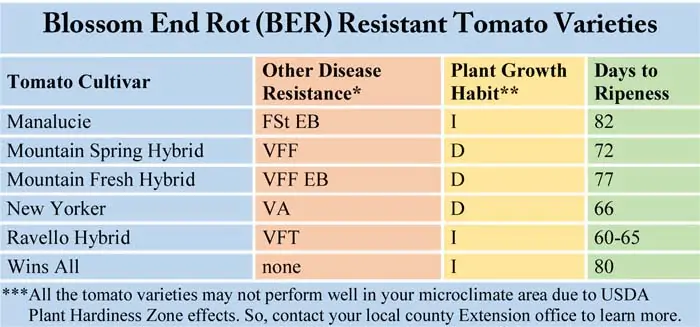
02: Blossom Drop
Blossom drop is a temporary tomato plant problem caused for extreme temperature fluctuation. When the temperature goes too high or too low, flowers dry up, and blossom drop before the formation of fruits.
This is very common in tomato and pepper plants, and you need to be patient to let the problem be gone by itself.
There have several issues for blossom drop, but temperature fluctuation is the main reason.
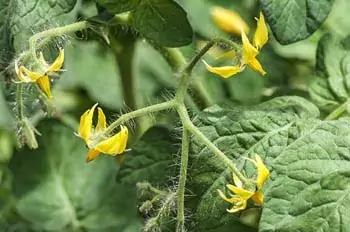
Causes and symptoms:
Blossom drop occurs when the night time temperature drops below 55° Fahrenheit or 12° Celsius and daytime temperature above 86°Fahrenheitor29°Celsius.
Inadequate pollination is another reason for the blossom drop. Flower pollination can be hampered due to temperature fluctuation, lack of insect pollinators, careless use of insecticides, or lack of proper humidity range in between 40-70%.
Careless fertilization can imbalance the soil nutrients, which hampers blooming healthy flowers.
Overhead irrigation and frequent summer rainfall can increase soil moisture if you don’t have a proper drainage system. On the other hand, low soil moisture due to lack of irrigation or drought can also encourage blossom drop.
Sometimes blossom drop happens when Tarnished plant bug attacks the vegetable flower stem.
Plant stress due to surviving disease can also be a reason for blossom drop.
Treatments and controls:
Disease-resistant tomato variety: “Not available” contact the local extension center for suitable varieties in your area.
- Choose tomato varieties considering the USDA hardiness zone and microclimate condition of your local area.
- Don’t plant warm-weather tomato varieties in cooler conditions.
- Avoid early planting and when the day and nighttime temperatures do not constantly remain suitable for the plants.
- Fertilize your garden soil on time to balance soil nutrients.
- Try to use organic matter for fertilizing, and keep in mind that overhead fertilization doesn’t increase fruit production.
- Use pesticides after sunset because pollinators come to your garden in the daytime. Besides, plant some nectar-rich flowers surrounding your vegetable garden to attract bees and other pollinators. Manually shaking or tapping your tomato plants is the last option to get pollinated.
- Arrange a proper drainage system to control moisture in the soil and deeply irrigate once a week in drought or dry season.
- Use effective pesticides to get rid of Tarnished plant bugs if you notice them in your garden. They look very small, around 7 millimeters long, oval in shape, flat, and brownish in color.
03: Buckeye Rot
Buckeye rot on tomato is a soil-borne fungal disease caused by three species of Phytophthora: P. capsici, P. drechsleri, and P. nicotianavar. parasitica. This fungus develops in warm and wet conditions and can survive several years in the soil. Fruits may be affected when they touch the soil. They are commonly found in the southeast and south-central regions of the United States.
Buckeye rot disease can affect tomato, pepper, potato, tobacco, pineapple, and many other hosts.
Causes and symptoms:
Buckeye rot performs better in warm and wet weather when the temperature remains between 75°- 86°Fahrenheit or 24°-30°Celsius.
A small brownish water-soaked concentric spot appears on soil touched portion of the fruit and is finally shaped like a bull’s eye.
Buckeye rot appears on both green and ripe fruits, and it can travel through rainwater or surface water. The poor drainage system is another reason to thrive this disease.
Treatments and controls:
Disease-resistant tomato variety: “Not available” contact the local extension center for suitable varieties in your area.
- No disease-resistant varieties have been found to avoid this disease. So cultural and chemical control is necessary.
- Planting in a raised bed and a proper drainage system will help to reduce the risk of the pathogen existing in the soil.
- Plant staking and caging help to prevent the disease.
- Rotate crops and avoid solanaceous plants in the same field next season.
- Apply fungicides that contain chlorothalonil, maneb, mancozeb, or metalaxyl through the sprayer to control the pathogen. Follow the fungicides label instructions and restrictions to get better output.
04: Gray Wall
The grey wall on tomatoes is a fruit ripening problem that creates blotchy patches on the fruit wall. Also known as blotchy ripening.
This mainly causes environmental effects and typically attacks the greenery fruit. Stems and leaves are not affected by this problem like a mosaic virus.
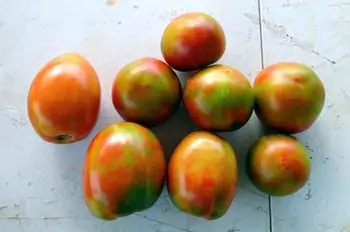
Causes and symptoms:
Symptoms included grayish or brownish patches on green fruit. Spots develop inside and outside of the tomato fruits during the ripening period and turn yellow.
The problem performs better in extreme heat or high humidity as well as cool, wet, or cloudy weather.
Signs appeared on densely growing plants or plants holding a lot of foliage, prevent to get enough sunlight on tomato fruits which occurs uneven ripening.
High nitrogen in soil produces more foliage and reduces the performance of the tomato plant also promotes patchy ripening. Imbalanced soil nutrients such as low potassium and boron contribute to blotchy ripening too.
Treatments and controls:
Disease-resistant tomato variety code: “GW”
- Check your garden soil nutrients before planting each year.
- Provide proper fertilizer according to the soil test report of your garden to reduce the risk of uneven ripening.
- Water your tomato plants regularly in the dry season and ensure a proper drainage system.
- Make sure your tomatoes get enough sunlight to get ripen.
- Sometimes mild pruning works when you notice extreme foliage growth, but don’t prune too much, which causes sunscald.
- Find disease-resistant (mosaic virus) plant varieties to avoid this problem.

05: Anthracnose
Anthracnose of tomato is a fungal disease caused by the pathogen Colletotrichum, which mainly attacks green tomatoes. However, green fruits do not show symptoms before the fruits begin ripening.
Anthracnose usually attacks the fruits and sometimes harms the stem and foliage. In a greenhouse setting, the fungus may affect the roots.
This disease can be a red alert for tomato growers and is very devastating. There is no cure for the disease, so taking some preventive steps is the only way to reduce the risk.
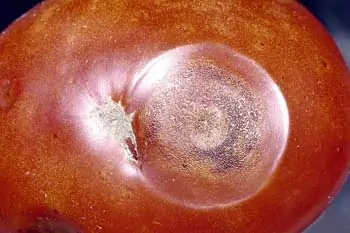
Causes and symptoms:
Anthracnose spread out in moist and humid conditions and moves through the water.
Eggplant, pepper, and potatoes are also hosting the disease.
Symptoms mostly appeared on ripened fruits rather than green fruits, although green fruits also are affected.
Anthracnose creates small sunken, watery ring spots on ripe tomatoes. They gradually become larger, then sink into the fruits and turn a dark grayish color. You can find several lesions in a single fruit, and when they spread, they join together and mark a large rotten section.
Fruits’ contact with soil has more possibility of becoming affected by anthracnose.
This fungus works in a wide range of temperatures but performs better at 68°F to 75°F. Wet and humid weather influence to spread of pink or orange mosses, which occur fruit ripening.
Colletotrichum fungi can survive on infected plant debris, and sometimes the disease may be seed-borne.
Treatments and controls:
Disease-resistant tomato variety code: “A”
- There have no disease-resistant varieties, so collect high-quality tomato seeds.
- Apply fungicides on the soil before planting.
- At least a two-year crop rotation can help you to prevent the disease. Avoid planting the same plant family corps like pepper, eggplant, and potatoes in consecutive years.
- Staking tomato plants and plastic mulching can protect your fruits from touching the ground.
- Remove weeds and susceptible host plant debris.
- Picking up fruits as early as possible when ripen to reduce the risk of developing Anthracnose fungus and use them quickly because this method won’t keep your fruit fresh for a long time.
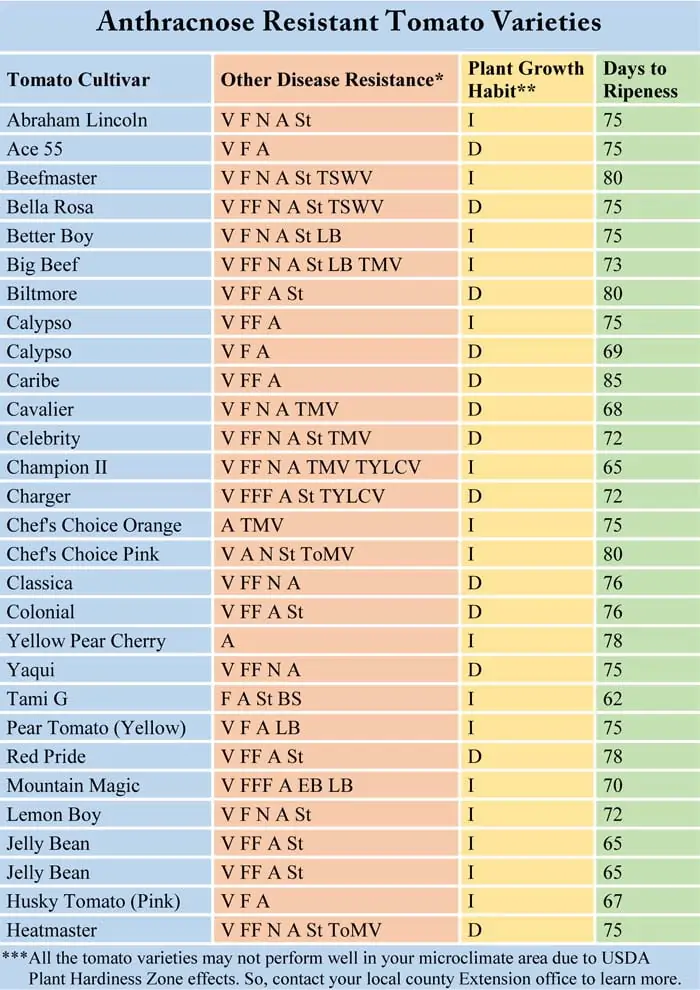
06: Fruit Cracks
Tomato fruit cracks, also known as tomato fruit splitting, is a common fruit problem that occurs in both environmental and physiological conditions.
Temperature fluctuation in spring, sudden rainfall during the dry season, overhead watering, imbalance soil fertilization, and several other issues associated with fruit cracking.
Typically, there are two types of fruit cracking such as concentric splitting, which is surrounded by the fruit’s bud, and radial crack, which is vertically extant from the fruit stem to downwards.
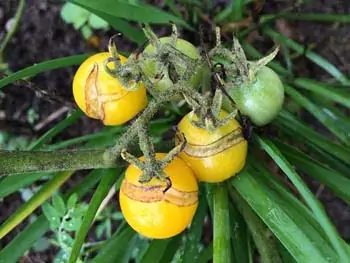
Causes and symptoms:
Excessive watering and heavy rainfall after the dry season cause fruit cracking. The tomato interior absorbs extra water too fast and grows thoroughly that the skin of the fruit cannot stretch enough to take the extra load and split.
Rapid exposure to soil moisture and humidity pushes the tomato fruits to grow faster and resulting in fruit cracks.
Irregular watering in warm and wet weather also occur tomato fruit cracking.
Temperature fluctuation during spring and late summer is another reason for fruit cracking.
Treatments and controls:
Disease-resistant tomato variety: “Available”
- Find some split or crack-resistant tomato varieties regarding your planting zone.
- Mulching is another way to hold and control soil moisture which prevents fruits from cracking.
- Maintain a scheduled water supply throughout the season.
- Watering tomato plants deeply in dry conditions so that subsequent rainfall doesn’t harm the skin, which results in fruit cracks.
- Install an automatic irrigation system, or ask your neighbor to water your plants when you are on vacation.
- A proper drainage system helps to flow out the heavy rainwater and overhead irrigation water from your garden bed.
- Check your garden soil to apply a balanced fertilizer, which helps to reduce the risk of the disease. Overfertilization occurs in extreme plant growth, follow-on fruit cracking.
- Pick up the cracking tomatoes at the early stage to reduce the damage. You can eat the cracking fruits if you harvest them earlier.
- There is no chemical treatment for fruit cracking.
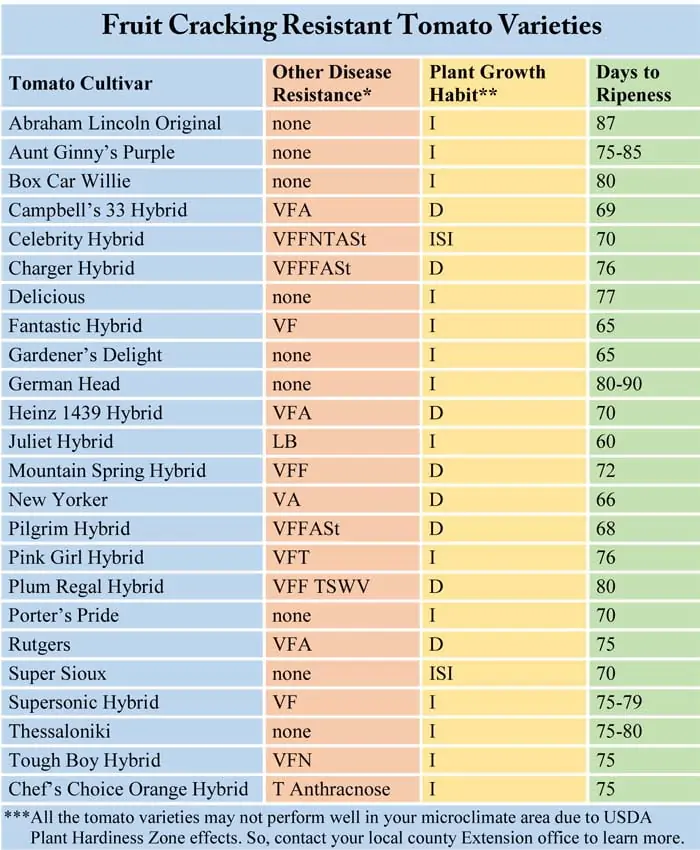
07: Early Blight
Early blight of tomato is a common fungal disease throughout the United States which can affect the leaves, fruits, and stems of tomato plants. It causes by the pathogen Alternaria Tomato Phila or Alternaria Solani.
This disease mainly attacks older plants as well as seedlings. It makes weaken the plants and reduces production.
Besides, eggplants and potato plants also are affected by the disease.
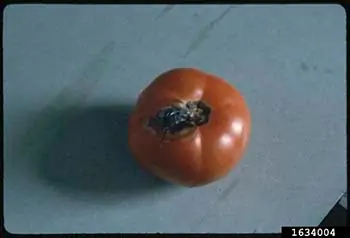
Image Source: Penn State Department of Plant Pathology & Environmental Microbiology Archives, Penn State University, Bugwood.org
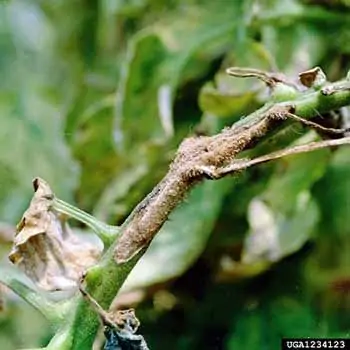
Image Source: Clemson University – USDA Cooperative Extension Slide Series, Bugwood.org
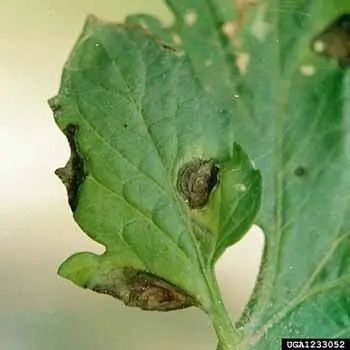
Image Source: Clemson University – USDA Cooperative Extension Slide Series, Bugwood.org
Causes and symptoms:
At the beginning stage, small round dark spots appear on the older leaves near the soil. Gradually the spots grow larger and turn brown moreover, tissues around the spots turn yellow. Finally, the leaves die and fall off.
Older stems turn dry brown when infected, as well as a seedling stems near the soil line also turn brown, sunken, dry, and ultimately fall off.
Fruits become infected near stems and crate dark leathery spots and finally drop from the plant.
Disease performs better in warm and humid conditions when the temperature goes 75°-86°F as well as after a heavy rainfall or dew where humidity reaches above 90%.
This fungus can survive in plant debris in the soil and spread out through wind exposure and water splash. The disease can also be spread by seeds, insects, or garden tools.
Treatments and controls:
Disease-resistant tomato variety code: “EB”
- There is no cure for early blight. So, plant disease-resistant tomato varieties and collect seeds from disease-free plants.
- You can also buy seeds from renowned seed companies to avoid this problem.
- Remove infected plant debris by burning or burying them in the ground. Don’t make compost from them.
- Pruning and staking plants prevent the spreading of spores from one plant to another. Develop air circulation with proper spacing between plants to keep them dry.
- Don’t walk in the garden after irrigation and rainfall or when the soil is wet.
- At least a 3-year crop rotation can reduce the risk of spreading out the disease. Avoid planting eggplant, pepper, or potato in the subsequent year where you last time planted tomatoes.
- Use a raised bed or container for planting tomatoes and improve the drainage system.
- Deeply water your plants rather than the overhead watering.
- Don’t water over the plant leaves because it helps to spread out disease from one plant to another. You better water on the ground around the plants.
- Sanitize your garden tools and wash your hand and shoes after working in the garden each time.
- Mulching can prevent the spreading of the spores of the disease.
- Apply copper-based fungicides to protect your plants from diseases. You can also find some chemical fungicides in your local gardening store or online shops.

08: Late Blight
Late blight of tomato is a devastating plant disease caused by the pathogen Phytophthora Infestans. It is a fungus-like disease that can affect the leaves, stems, and fruits of tomato plants and resulting in death as well as total crop failure.
This pathogen can spread out rapidly and is a great threat to commercial and home gardeners.
Tomato and potato plants are mostly affected by this disease.
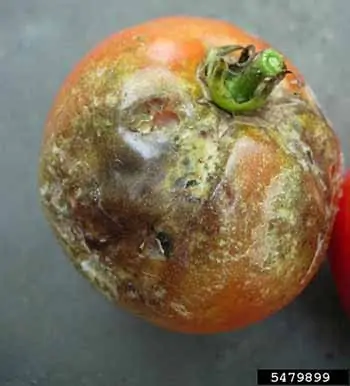
Image Source: Elizabeth Bush, Virginia Polytechnic Institute and State University, Bugwood.org
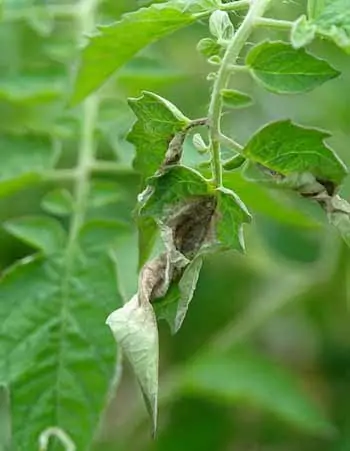
Image Source: Scot Nelson
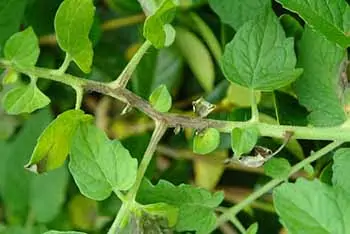
Image Source: Scot Nelson
Causes and symptoms:
This pathogen is a water mold that only flourishes when it finds cool and moist weather conditions when the temperature remains between 60° to 75°Fahrenheit. And it cannot spread out in hot and dry weather.
Typically, the pathogen cannot survive in dead plants, and it doesn’t appear every year.
Symptoms included water-soaked spots on leaves, and soon they turn into brown blotches, which ultimately kill the leaves.
Stem infections create dark brown lesions with clear edges.
Fruit infections appear as brownish lesions on the surface of the fruits.
Treatments and controls:
Disease-resistant tomato variety code: “LB”
- There are some disease-resistant varieties to prevent late blight tomato disease.
- This is not a seed-borne disease, so you can collect seeds from infected plants.
- Purchase spotless, healthy, and vigorous seedlings from the nursery to reduce the risk of the disease and ensure they are late blight resistant.
- Always keeps concerned about purchasing tomato seedlings and other host plants because the pathogen only survives in living plant tissue.
- If you notice the infections earlier in a few tomato plants, immediately remove the plants from the field and destroy them with herbicide or burn them.
- Use fungicides to manage infected tomato plants.
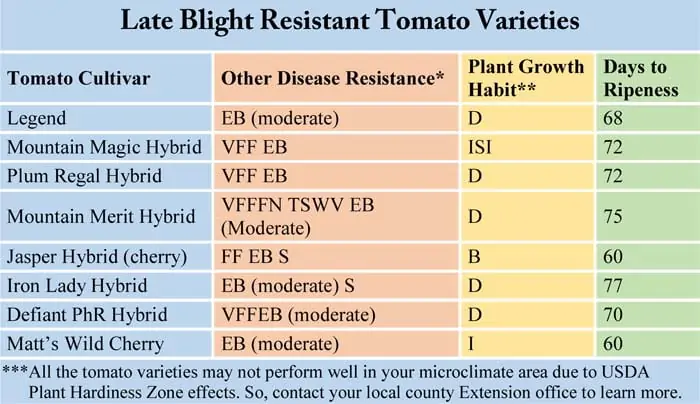
09: Bacterial Speck
Bacterial speck is a common tomato disease caused by the pathogen Pseudomonas Syringae Pv. Tomato. Pathogen thrives in cool and wet weather conditions and mainly affects the tomato foliage, stem, and fruits.
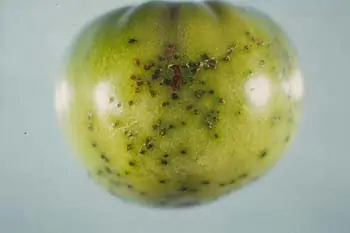
Image Source: Scot Nelson
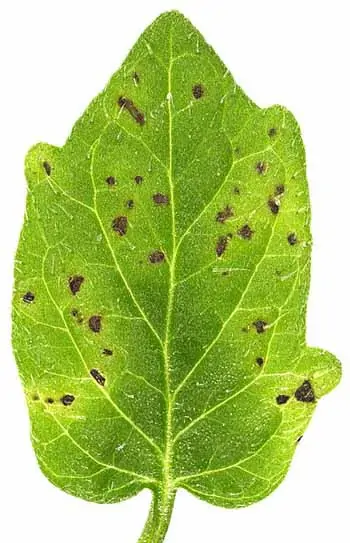
Image Source: Alan Collmer, Cornell University [CC0]
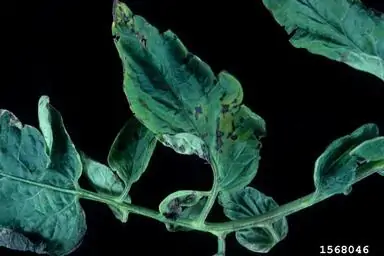
Image Source: Edward Sikora, Auburn University, Bugwood.org
Causes and symptoms:
The disease may come to your garden through contaminated seeds or seedlings
Pathogen thrives in temperatures between 60°-75° Fahrenheit, including in wet weather.
It may circulate throughout the garden by rainwater or splashing irrigation water. Besides, it may also spread out through hands or garden tools.
Symptoms included small dark spots surrounding yellow edges, which first appear on older foliage and then gradually move to younger foliage.
Fruits also appear the symptom of pinpoint-like brown or black spots.
Treatments and controls:
Disease-resistant tomato variety code: “BS”
- There is no treatment once the plants are affected, so collect seeds from a reliable garden store or seedlings from a reputed nursery.
- You can also apply seed treatment such as soaking seeds in 125°F water for twenty minutes or soaking seeds in a 20% Sodium hypochlorite solution for thirty minutes.
- Avoid sprinklers to water tomato plants, and always water on the ground around the plants, not over plant leaves.
- Avoid wet fields to work, and always sanitize your garden tools after work.
- Sometimes copper spraying may be effective in reducing the risk of some bacterial and fungal diseases.
- Remove garden plant debris and burn them.
- Rotate the crop field and ensure a proper drainage system.
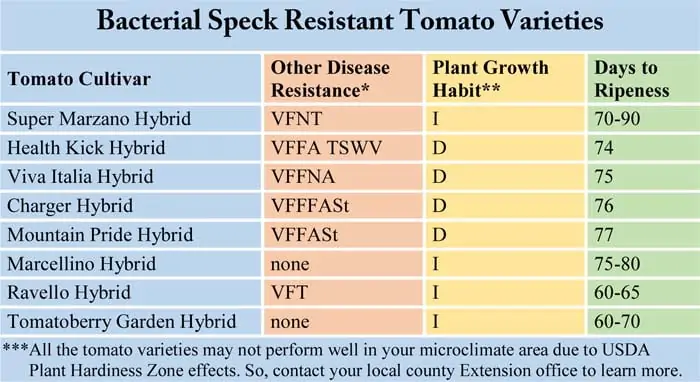
10: Bacterial spot
The bacterial spot of tomato is a devastating disease caused by four pathogens like Xanthomonas
Wet and humid weather favors the pathogens to spread out.
The infected fruits are unmarketable and make a big loss to the growers.
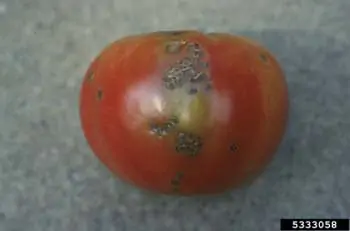
Image Source: Mary Ann Hansen, Virginia Polytechnic Institute and State University, Bugwood.org
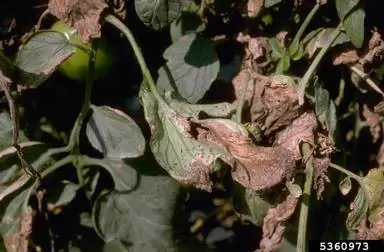
Image Source: Howard F. Schwartz, Colorado State University, Bugwood.org

Florida Division of Plant Industry , Florida Department of Agriculture and Consumer Services, Bugwood.org
Causes and symptoms:
A warm and wet climate with a temperature between 75°-86° Fahrenheit is the optimum condition for to spread of the disease.
Bacterial spot typically affects the ground parts of tomato plants, including leaves, stems, and fruits.
Initially, black tiny spots surrounded by yellow edges appear on leaves. Gradually the leaves turn yellow and finally die and drop off.
Fruits become infected at the greenery stage and occur dark brown spots. Lesions are very similar to bird’s eye spotting, brown and scabby. Once the spots appear on fruits, they grow on them but don’t rot them.
Treatments and controls:
Disease-resistant tomato variety: “Not available” contact the local extension center for suitable varieties in your area.
- There has no cure if the plants are once affected by bacterial spots. So perversion is the right way to reduce the risk of the disease.
- Use certified transplants and seeds for your garden. Do not plant infected plants or seeds from infected fruits.
- Avoid the field if it has been previously affected by the disease for at least a year. Don’t cultivate other host plants like pepper in that field too.
- Use a copper spray or other herbicides recommended by the local extension center to prevent the disease.
- Maintain a spraying schedule based on the weather and the presence of the disease.
- Apply hot water treatment to kill the bacteria that exist in seeds.
- Remove plant debris and burn them at the end of the season.
- Do not work in the wet field, and confirm the proper drainage system.
11: Bacterial Canker
Bacterial canker of tomato is a serious bacterial disease caused by the pathogen Corynebacterium michiganense or Clavibacter Michiganensis. It can affect both home gardens and greenhouses.
Once it appears, it can destroy all the surrounding tomatoes, including fruits, leaves, and stems.
It is a seed-borne disease comfort to perform better in comparatively warmer and highly moist weather conditions.
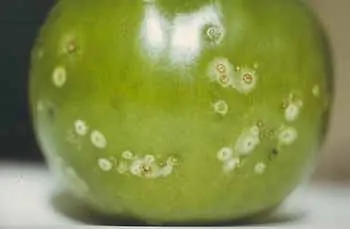
Photo Courtesy: Scot Nelson
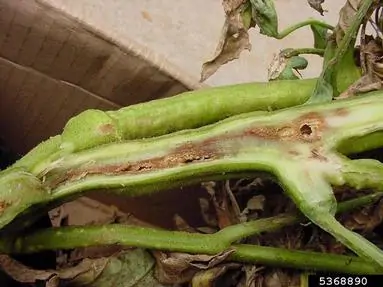
Image Source: Paul Bachi, University of Kentucky Research and Education Center, Bugwood.org
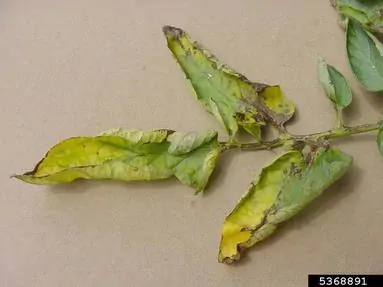
Image Source: Paul Bachi, University of Kentucky Research and Education Center, Bugwood.org
Causes and symptoms:
Identifying the disease at the initial stage is so difficult because there have several symptoms which may occur at any stage of the plant’s growth.
A temperature between 75-90° Fahrenheit with high moisture helps to spread out the disease.
Seedlings become wilted due to the attack of the pathogen, and tiny white raised spots appear on leaves.
Yellow to tan patches appear on leaves with brown edges, and the entire plant wilts and die.
The fruits showed bird’s eye resemble creamy white spots.
Treatments and controls:
Disease-resistant tomato variety: “Not available” contact the local extension center for suitable varieties in your area.
- Bacterial canker is a confusing disease for tomato growers to identify due to its wide area of symptoms. Moreover, the disease has no chemical treatment and more infectious comparing other tomato diseases.
- The best way to overlook the disease is by collecting disease-free seeds from certified seed companies. Don’t save your seed for the next year’s cultivation if your local weather condition favors or is infested by the disease.
- However, if you use non-certified seeds, you must soak them in a solution of 1-part germicidal bleach to 4 parts water for 1 minute. You can also soak them in 125°F water for 20 minutes.
- None of the treatments will ensure 100% disease-free seeds. So, you must have to monitor the plants closely throughout the growing season.
- Rotate your crop circle and avoid planting tomato-related host plants like eggplants, peppers, and potatoes for at least three years.
- Buy disease-free seedlings from a reputed nursery and never purchase the transplants which are pruned.
- Do not work in the garden in wet conditions after rainfall, irrigation, or dewdrop.
- Sterilize the garden soil when using a greenhouse or seedbeds. Remove infected plant debris and bury them at the end of the season.
12: Mosaic Virus
Tomato mosaic virus (ToMV) is an unpredictable soil-borne fungal disease. This is hard to identify the disease without testing in a plant diagnostic lab.
Symptoms may vary on the tomato varieties, environmental conditions, soil nutrients, and so many factors.
It has a wide range of hostages, including tobacco, potato, pepper, eggplant, and other nightshade family plants. It can also attack lettuce, cucumbers, beets, apples, pears, cherries, and so many plants.
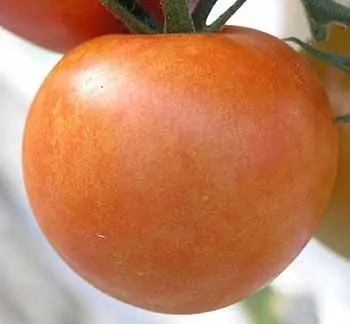
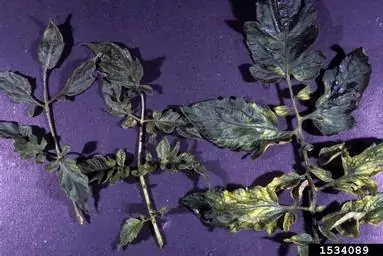
Image Source: University of Georgia Plant Pathology , University of Georgia, Bugwood.org
Causes and symptoms:
The virus can be found at any stage of plant growth, and once appears, there has no cure.
The pathogen of the mosaic virus can survive in the soil and plant debris for several decades.
Hamper plants’ growth and reduce yields.
Leaves may be curled and mottled yellow on green leaves.
The disease may appear in greenhouse conditions where found in low light and low temperatures in winter.
Infected plants produce fewer fruits, and leaves become stunted.
The inside of infected fruits may show brown areas.
Treatments and controls:
Disease-resistant tomato variety code: “T” or “ToMV” or “TMV”
- There has no chemical treatment for the mosaic virus. So, use disease-free seeds or seedlings from reputed sources.
- Remove and burn all the infected plants.
- Do not collect seeds from infected fruits.
- Do not work in wet conditions in the garden.
- Always wash your hands and sanitize your garden tools after working in the field.
- Milk nutrients can kill the germ of the disease. Take one liter of milk and mix it with 20 liters of soapy water. Sterilize your garden equipment and wash your hands with the milk solution.
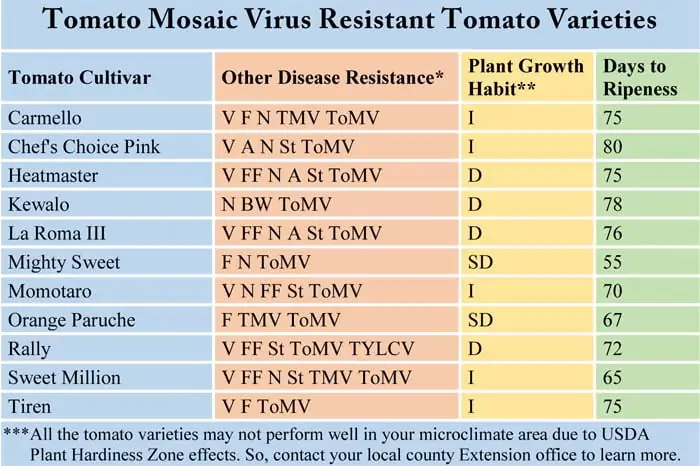
13: Sunscald
Sunscald is a common noninfectious disease of tomatoes, mainly occurring when they are exposed to direct sunlight during extremely hot weather.
Environmental effects are mainly responsible for the disease, and sometimes the gardener doesn’t have any control over the situation.
It may also occur due to fungal (Solanum lycopersicon) effects.
If your garden is situated in a heat zone, according to the American Horticultural Society (AHS), you should take some precautions when planting tomatoes to reduce the risk of sunscald.
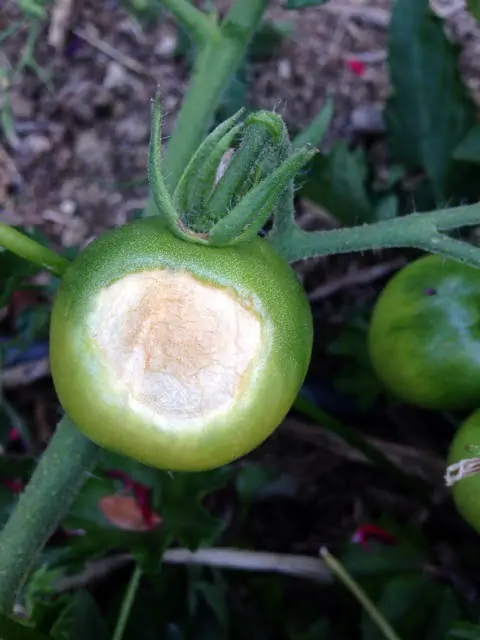
Causes and symptoms:
Symptoms appear as yellowish or pale white spots on the side or upper half of the fruits where they directly expose to sunlight.
Constant sun exposure to the infected area produces a blister, and gradually, the infected area turns thin, dry, wrinkled, and papery surface.
Moreover, the scalded area is later susceptible to secondary fungi like Alternaria.
Extreme or late pruning may cause sunscald.
Leaves drop off due to pests, and diseases attack also causes the problem.
Lack of nitrogen during the setting of fruits can lead to sunscald.
Treatments and controls:
Disease-resistant tomato variety: “Not available” contact the local extension center for suitable varieties in your area.
- Sunscald can’t be cured once it appears. So, you can take some preventive steps to protect your tomato fruits from the extreme heat of the sun. Grow some tomato varieties that favor the planting zone you live in.
- Disease-resistant tomato varieties also help to prevent sunscald because sunscald may appear on tomatoes after attacking of pests and diseases.
- Mulching can create a protective barrier and save your plants from soil-borne diseases.
- Caging and staking of tomato plants with proper spacing can reduce the risk of extreme sun exposure.
- Sometimes you may need to remove foliage around your tomato fruits before they mature. In that case, you can provide supplementary shade during extreme heating times of the day.
- Avoid over-pruning of plants during hot weather conditions. The foliage can give extra shade to your tomatoes.
14: Poor Fruit Set
Tomato plants holding enough foliage and a lot of flowers but no fruit set are usual to complain getting from the tomato growers.
If you find the same types of problems in your garden tomatoes, it may occur for unfavorable weather conditions, temperature fluctuation, irregular watering, imbalanced fertilization, and poor growing condition.
Don’t be overwhelmed; the roots of the problems are often predictable and easy to fix.
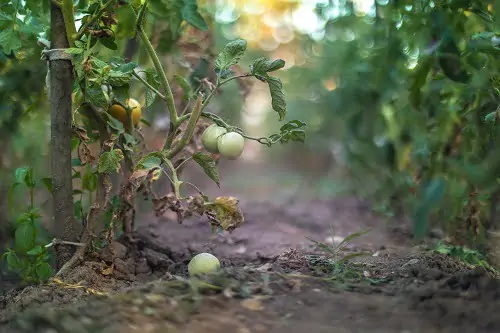
Causes and symptoms:
Poor fruit set of tomatoes can occur due to insufficient pollination, although tomato flowers can pollinate by themselves.
However, insufficient pollination may occur due to a lack of wind exposure and insect pollination in greenhouse conditions.
Insufficient places between tomato plants can also produce fewer fruits.
Besides, extremely hot weather conditions when the daytime temperature rises and constants above 86°For 30°Cas well as night time temperature remains above 24°C or 75°F can make a disaster in the normal pollination process.
Imbalanced fertilization and lack of required nutrients when setting fruits on plants can lead to poor fruit setting problems.
Lack of sunlight exposure due to extreme foliage can also make poor fruit sets.
Tomato plants need a minimum of eight hours of direct sunlight to produce healthy fruits. The shade of large structures or big trees may be a barrier to healthy fruit sets.
Irregular or little water to the plant also leads to less fruit set.
Treatments and controls:
Disease-resistant tomato variety: “Not available” contact the local extension center for suitable varieties in your area.
- Plant some beneficial flowers around your garden to attract bees and other natural pollinators.
- Greenhouse and polythene tunnel tomato growers can open up their doors and vents to access air circulation inside the greenhouse structure for easy pollination. It can also help to control humidity inside the tunnel and greenhouse as well as reduce the risk of the disease.
- Proper spacing between plants can help to circulate air in an open field, which helps more pollinate and produces more fruits. It also helps to control some diseases.
- Maintain a schedule for watering tomato plants and take some extra care when extremely hot weather is going on.
- Apply the required fertilizers when preparing the soil to plant tomatoes in the garden.
- After that, fertilize the plants again during they start setting fruits and continue mild fertilizer once every one or two weeks until the season end. (Learn more about fertilizing tomatoes)
15: Catfacing
Tomato cat facing is mainly a physical deformity of fruits that may cause by various uncertain reasons. Commercial tomato growers, as well as home growers economically affected by this disease.
Infected tomato fruits look very wired and shaped like a face of a cat.
However, you can eat the fresh part of the infected fruit. It doesn’t change the taste of the fruit and is not even harmful.
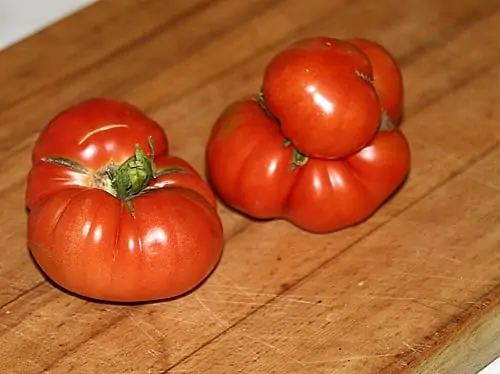
Causes and symptoms:
There was no specific reason for happening the problem, and little research has been done on this disease.
Fruits appear dark brownish scar tissue sunken on the fruit wall and swelling.
When the temperature remains below 24°C may be susceptible to facing.
Imperfect pollination and physical damage to blossoms can lead to the disease.
The problems are more vulnerable to heirlooms or larger fruit varieties.
Excessive pruning and exposure to herbicides also can cause cat-facing deformity.
Treatments and controls:
Disease-resistant tomato variety: “Not available” contact the local extension center for suitable varieties in your area.
- There has no specific solution to control the disease. Only preventive measures and maintaining the proper guidelines of tomato cultivation can help to reduce the risk of the disease.
- Find varieties that have no historical track record of being affected by facing disorder.
- Plant after the ground-level temperature rise above 55°F.
- Monitor your garden soil temperature fluctuation and be patient until the situation is normal.
- Confirm a proper drainage system for your tomato plants.
- Planting tomatoes with proper spacing between plants.
- Don’t use high nitrogen fertilizer if not needed, as well as avoid excessive pruning.
How to read tomato codes
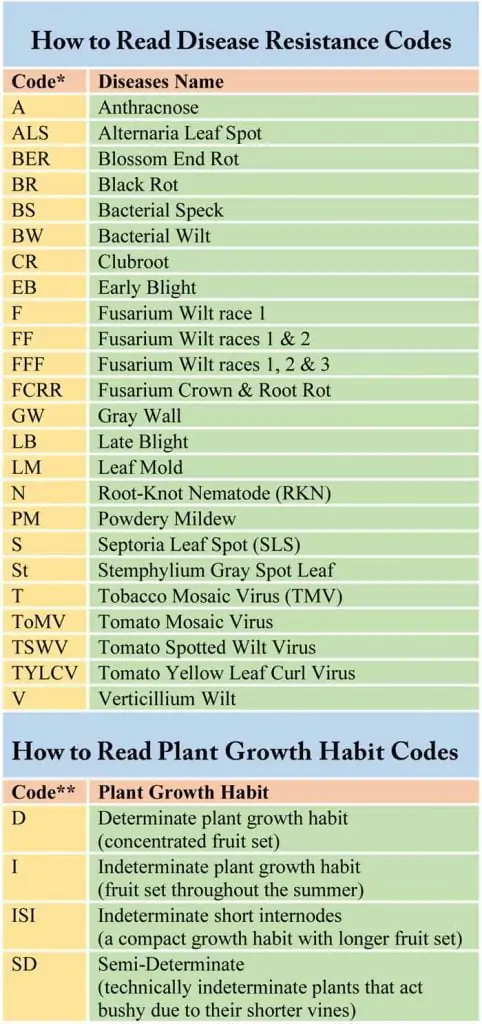
Conclusion:
Some tomato fruit problems are easily identifiable, and some problems may happen for several reasons. Here I discuss, in short, the causes, symptoms, and possible solutions to the most common fruit problems of tomatoes.
To learn more, share your experience with your neighbor gardener or contact the local county extension office.
Read More:
*** 7 Basic Reasons Behind Common Tomato Plant Problems
***10 Common Tomato Leaf Problems and Solutions
*** 5 Common Tomato Stem Problems and Solutions
Sources and Citations:
- https://hgic.clemson.edu/factsheet/tomato-diseases-disorders/
- http://www.ladybug.uconn.edu/FactSheets/late-blight-of-tomato-and-potato.php#
- https://content.ces.ncsu.edu/bacterial-spot-of-pepper-and-tomato
- https://extension.umn.edu/diseases/bacterial-canker-tomato
- http://www.tomatodirt.com/gray-wall.html
- https://www.gardeningknowhow.com/edible/vegetables/tomato/tomato-bacterial-speck.htm
- https://www.gardeningknowhow.com/edible/vegetables/tomato/catfacing-fruit-deformity.htm
- https://www.growveg.com/guides/top-3-reasons-why-your-tomatoes-are-not-setting-fruit/

